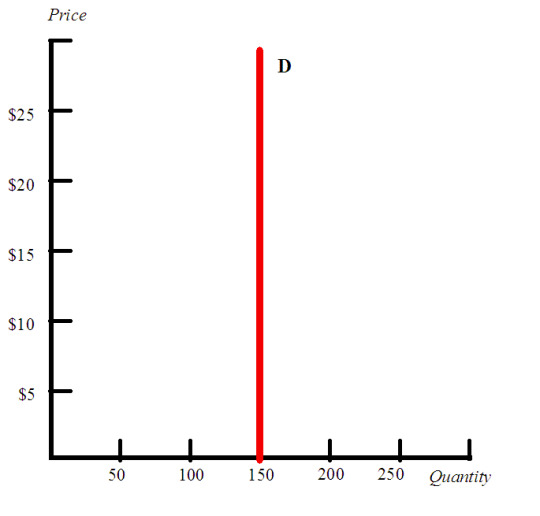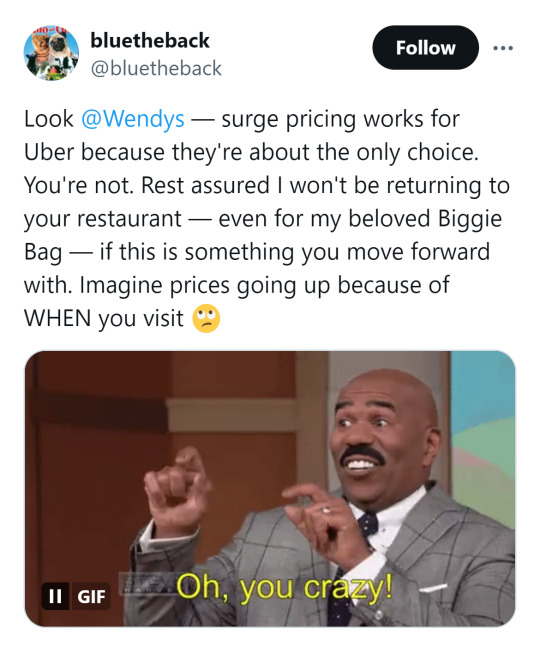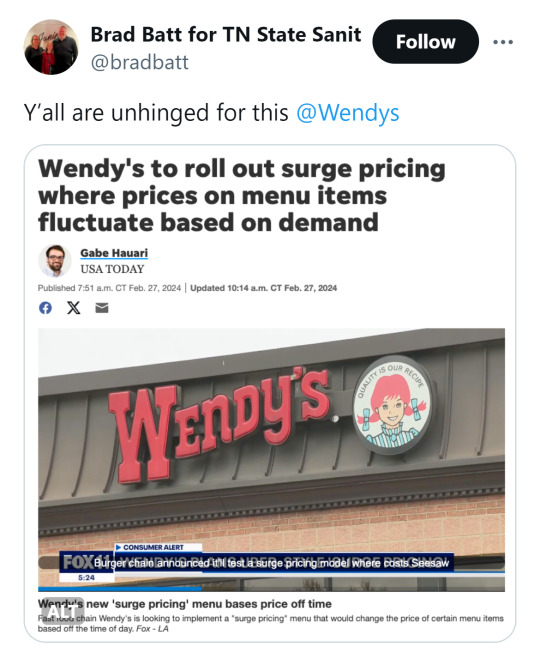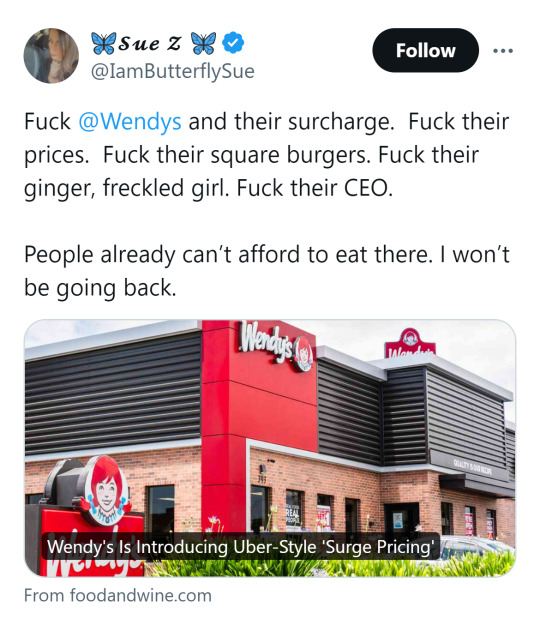#Demand-supply
Text
I'll let y'all fanfic readers in on a little secret: if you find a writer who portrays your favs or that specific trope just right and you want to get more of it, the trick is reblogging or even just commenting and/or going wild in the tags, and you'll probably get more
listen, I am but a simple duck, if you feed me I'll just FEAST on those crumbs and you can bet your ass I'll come back to that pond for some additional bread crumb feasting
#writing#writing nightmare#fanfiction#fanfic#fanfiction writers#writers#writing problems#like i write for myself ok#but i can be encouraged into writing stuff#it's like.... an eco system#SUPPLY AND DEMAND IF YOU WILL EXCEPT IT'S NOT TERRIBLE AND DESTROYING THE PLANET#everybody WINS#mine
19K notes
·
View notes
Text
It really annoys me when misogynists bring up the whole ‘why wouldn’t everyone just hire women if they can get away with paying everyone less’ because this is such a simplistic take on a complicated issue and doesn’t factor in the following
1) Places already do this anyway. And then they enforce pay secrecy so women are unable to talk about their wages
2) It’s not always about who is cheapest to hire - it is also about who is going to produce the better quality of work and who is going to fit into the team better. In a team dominated by men, who did they think is going to fit into the team better? Another man. In a team full of misogynists who devalue women’s work, who did they believe will do better quality work? A man. Yesterday, I was watching a video where a woman said that she met another woman who was in charge of a team and openly admitted that she would not hire a woman to be part of this team because it would cause too many issues because of sexual harassment claims. These are things people will consider when hiring.
3) It’s simplifying the issue down to ‘all women are paid less than all men in all fields across all levels’ which isn’t true. Some of the pay differences are as a result of women in the same fields doing the same jobs as men but paid less (point 1), but a lot of it comes down the the following two things:
Women are less likely to be promoted than their male colleagues which is the result of many factors including inherent misogyny (thinking women shouldn’t be in leadership, thinking their work is lower quality, etc), women being ‘less dedicated’ due to family commitments, and taking longer to have similar experience to male colleagues due to time off on maternity/raising children
Fields that are dominated by women are lower paid overall, even when comparing to jobs with a similar educational requirement. Teaching and nursing are both jobs which require degrees yet are some of the lowest paid public sector jobs. Female dominated cleaning jobs (eg: housekeeping) are lower paid than similar male-dominated jobs (eg: janitor). Labour seen as ‘women’s work’ is devalued and therefore paid less
4) Whenever we discuss these other factors, like mat leave and taking care of the children, it’s always seen as an ‘explanation’ for why women are paid less, rather than part of larger socio-economic issues leading to women being paid less. Literally saw so many things when I was younger about how it’s only like 2p/£1 rather than 23p/£1 or whatever because once you factored in all of these things above you’d find men and women in similar roles in similar fields are actually paid pretty evenly, without recognising how those reasons themselves are part of the problem. Women are pushed towards lower paid fields from a young age (teaching, nursing, care work, etc). Women are the ones who take months off on maternity leave while men might take two weeks. Women are the ones taking career breaks to look after the kids. Women are the ones working part time or flexible hours so they can look after their children. All of these things have negative impact on women’s income and they stem from misogyny. They shouldn’t be ignored in gender pay gays discussions or used to explain why the gender pay gays isn’t ‘real’.
#I will scream at anyone who says it’s supply and demand#that’s such obvious bullshit#supply and demand in labour markets is broken#there have been massive shortages in nursing teaching and care for YEARS#supply and demand would have doubled their salaries#but has that happened?
104 notes
·
View notes
Photo

#she sells sea shells on the sea shore#but the value of these shells will fall#due to the laws of supply and demand#no one wants to by shells cause there's loads on the sand
2K notes
·
View notes
Text
There was a limit to how many candles he should make, Trev had told Nutt. It looked bad if he made too many, Trev explained. The pointy hats might decide that they didn't need all the people. That made sense to Nutt. What would No Face and Concrete and Weepy Mukko do? They would have nowhere else to go. They had to live in a simple world; they too easily got knocked down by life in this one.
Terry Pratchett, Unseen Academicals
#nutt#trev likely#unseen academicals#discworld#terry pratchett#unseen university#worker solidarity#compassion#empathy#jobs#overachiever#limitations#negotiations#supply and demand#a simple world#i get knocked down
146 notes
·
View notes
Text


Flower delivery by Jack Wilson
#this looks so beautiful#cottagecore#flowers#flowercore#flower delivery#thinking about how hard this job must be and trying to enjoy the flowers is a weird thing#but without the latter there wouldn’t really be a former#huh#isn’t that something#nature#naturecore#photography#(as in without anyone enjoying flowers there wouldn’t be a need for flower delivery)#supply and demand baby
2K notes
·
View notes
Text
daisy/elias moodboard





#might fuck around and make a jane/jonah one too who knows...#if there's demand for it in the market i shall supply.#the magnus archives#tma#tma ships#daiselias#daisy tonner#elias bouchard#jonah magnus#alice daisy tonner
92 notes
·
View notes
Text




Farmer Zayn getting too attached to his animals
#zayn malik#ok whatever creating supply where there was no demand#but this is tumblr user formulaONEDIRECTION#i'm earning the url like jess said#everyone saying he doesn't look beautiful anymore...cap#nadia's things
191 notes
·
View notes
Text

Dragon Sickness
Inktober day 27. Beast
I will not part with a single coin
#my art#inktober#the hobbit#thorin oakenshield#say what you will about these movies but the way they played thorin’s growing descent into obsession was superb#that said the poor guy never gets any proper warnings and it’s all couched in#“the dwarves were greedy and deserved what they got#which isn’t how economy works#you’ve got to have a demand for the supply to be outstripped#either way#i thought it would be fun to make him more dragon-like#draconic#that was the word i was looking for#the hobbit art#Thorin Oakenshield art
79 notes
·
View notes
Text
Ko-Fi Prompt from Eli:
do landlords have price wars? it seems like with the insane way rents are going it wouldn't be hard for them to undercut competition. but it also doesnt feel like thats happening.
Oh, this is a fun one. Let's talk about price elasticity!
Note: I will be including graphs in this post. While it's helpful as a visual aid, there is no way to describe it that actually helps explain the premise that isn't already in the post's body of text. As such, I will not be providing image descriptions beyond the short sentence before or after stating what it's meant to represent, since further information wouldn't be of any use to those with screen readers.
In the field of microeconomics, one of the basic models everyone learns is the supply and demand curve. Here's a visual example:

Image Source: Wikimedia Commons
Traditionally, a product with an elastic price is one where demand fluctuates directly in response to cost, isolated from other factors*. A basic example is affordable luxury goods, say, a nice steak. If the cost goes up by a dollar, a certain portion of the population will decide it's no longer worth the cost, and will switch to something cheaper, like a chicken breast, instead.
* Other factors include, but are not limited to, luxury appeal, subsidized costs, and the lipstick effect. This post is already pretty long, so I can't go into many details on those situations.
The Demand curve is specifically a visualization of how much of a product can be sold for, not necessarily how much the product can be sold in quantity. As a general rule, it's easier to think of Price as the independent factor for Demand (and quantity as the dependent), and quantity as the independent factor for Supply (and price as the dependent).
With a traditional S&D curve, the intersection of the Supply and Demand curves is the optimal price point from both ends. The X-axis is supply quantity, which a lot of people find unintuitive... but that's where it's been for years and that's where it's staying.
If there is a great quantity of a product, with healthy competition levels, then the supply line moves to the right. The intersection of the lines then drops, and prices go down, as businesses lower prices to gain more customers.
If there is a small quantity of a product, due to limited raw materials or unique patents or skills, then the supply line moves to the left, and they can charge more for the product.
Here is a visual of what I mean by the supply curve moving:

(Source: Wikimedia Commons)
The text is fairly small, so I'll describe here: The image states that factors that can increase supply (shift to the right) include favorable conditions for production, falling input prices, improved technology, and lower taxes or regulation costs. The second graph describes a decrease in supply, causing a shift to the left, the factors of which are the exact inverse of the first graph for increased supply.
A good example of a shift in supply resulting in a change in cost is gas: prices go up when supplies go down, whether due to higher taxes/regulations (e.g. the current refusal to trade with Russia), or disappearing raw materials (diminishing quantities of oil and natural gas, as finite, unrenewable resources). Comparatively, other forms of energy, like solar, have had their quantity lines shift to the right (cheaper) as the technology becomes more efficient and cheaper to produc.
Now, in areas that genuinely do not have enough housing, this is part of why prices go up: options are limited enough that they can get away with charging more. Due to zoning laws, construction costs, etc. they cannot add more housing, and so the supply curve is further to the left (pricier).
Here is a similar example image for the Demand curve, and how it shifts:

(Source: Wikimedia Commons)
The factors, here, are more intuitive. If demand goes up for reasons like trends, population, rise in general disposable income, changes in the costs of competitors or accessories, or expectations of investment viability, then the demand curve shifts to the right, and costs can increase without losing market share. For the reverse causes, the curve shifts to the right, and fewer people are willing to buy at that same cost.
Let's consider laptop computers: they have gotten more popular. A larger portion of the population has reason to buy them than twenty years ago. For that reason, the price can go up without necessarily losing market share (shifting to the right). However, income across the board has dropped, and there is a reasonably cheaper substitute (smartphones) for some uses, so the demand is lower (shifting to the left).
If you are in a city where there are suddenly a lot of people moving in for some shiny new company, then there is a greater population trying to buy, and so the demand curve shifts to the right, and prices can safely go up without losing market share.
...but that's with elastic pricing and competition.
Elastic pricing and costs are for most traditional goods. For specific foods, you can usually just... buy something else. If a plague wiped out half the crop of lettuce for the season, the costs will rise on the supply side (shift to the left), but there are unaffected substitutes, like broccoli and cabbage and tomato, for general use, so demand will also drop (also shift to the left). This means that prices go higher, but they are further to the left for both, meaning the quantity sold is lower.
Selling four million units at $3 vs. selling two million units at $6. The final amount of money changing hands is the same, but it's at a different cost and quantity.
Summary:
Supply moves to the left: less product, higher price from the seller to cover costs
Supply moves to the right: more product with healthy competition, lower price from the seller
Demand moves to the left: less interest in the product, customers need a lower price to buy the same amount
Demand moves to the right: more interest in the product, customers will tolerate a higher price to buy the same amount
But again, this is for elastic products.
What's an inelastic product?
Well... housing, actually, but let's start on the other side this time.
Products with inelastic demand are ones where customers cannot respond to changes in cost or supply. It doesn't matter if the cost goes sky high, and you know the profit is 96% because the cost of production is 4% of the price you paid; you can't afford to not buy it.
You know how insulin prices in the US spent decades being prohibitively expensive because diabetic individuals could not survive without buying it? That's inelastic demand.

(Source: Wikimedia Commons)
If you look at the image above, you see a 'perfectly' inelastic demand curve. It is a straight, vertical line, where the quantity is immovably stuck at 150 no matter how high the cost goes.
In the real world, very, very few products are perfectly inelastic. Even insulin is... well, some people can move abroad. Not many, so it's pretty close to vertical, but some.
With housing, demand is fairly inelastic. The vast, vast majority of people do need housing. There are very few substitutes for this need, and while there is a range of prices and options, it does sort of... flatten out early.
If you demand that people spend $3000/month in order to live within 50 miles of their place of work, and everyone else is also demanding $3000/month, then there aren't any other options. The person either gets a new job elsewhere, spends a few hours a day on a commute, or pays those $3000.
Inelastic supply is the other side of that coin. The very limited quantity, and the high costs of expanding that supply, mean that the line shifts pretty far to the left, causing prices to rise. The line is also nearly vertical. With housing, there exists an argument that it is often cheaper to let the apartment sit empty than to rent it out too cheaply, due to maintenance costs and property taxes or what have you. Unless there's an exorbitant mortgage that needs to be contributed to by the tenants, though, those numbers don't quite work out.
So... if the Demand curve is nearly vertical, and the Supply curve is also nearly vertical, and there are no viable substitutes other than exiting the market entirely, you have a situation where the Supply side has nearly all the power and an excuse for why they're raising prices that doesn't actually reflect the reality.
Because there's plenty of housing being built, just, you know, not in the tax bracket that needs it. (Remember, a very large portion of Billionaire's row is currently unoccupied.)
You could argue that this is a form of price-fixing, which is an illegal act in which competitors in the same industry agree to collectively raise, lower, or stabilize pricing of a product. If 90% of microprocessor companies raise their prices simultaneously without cause, consumers will have to bite the bullet and buy the product at that new cost, as there aren't enough substitutes to find another option.
(If this sounds like a monopoly to you, good job! It's the same principle: control pricing for enough of the market that you can raise it higher than demand justifies. It's just done by making deals with the competitor instead of buying them out.)
However, due to the shape of the supply and demand curves in this housing market, and the very gradual way in which this situation has developed, it's not really a deliberate, organized price-fix, just something that came about as landlords realized that tenant's rights and alternate options (e.g. the council/public housing, affordable housing lotteries) weren't keeping up with their ability to continue to nudge prices upwards without losing out on money.
(Most of the time. Price-fixing does still happen, in pockets.)
Long story short: landlords don't have price wars because the demand curve is so inelastic that they can basically get away with anything.
(Prompt me on ko-fi!)
#economics#housing#housing industry#supply and demand#supply curves#demand curves#ko fi prompts#economics prompts#microeconomics#phoenix posts
201 notes
·
View notes
Text


Kings of Frost 👑
#more HF.Ex and the Winter King because there was demand#supply and demand ya know#deltarune#spamton g spamton#spamton#deltarune chapter 2#deltarune spamton#deltarune au#fionna and cake winter king#Spamton HF.Ex#winter king#eternal winter au#fionna and cake
107 notes
·
View notes
Text
#CultivateElev8#on Tik Tok#awareness#gas#gas stoves#fossil fuels#rockefeller had petroleum classified as a ''fossil fuel'' in the late 1800's#fossil fuels are ''apparently created by rotting plant & animal life from the imaginary dinosaur era''#one problem with this Theory is petroleum is found much farther in the Earth than any plant or animal life would be found#in fact the majority is found that way#Petroleum is the Second Most Abundant Source of Liquid Found on Earth#Water is the First#there is no Supply/Demand Issue with Petroleum...it is all a Theory Tail created by the parasites so they can Control & Manipulate YOU#NOT to mention Steal from Your Pocket Book...but then the parasites got you paying for Water now...soon it will be Air!!#do your own research#challenge what you know#the lies are many#the story of Your History & the things You have been taught in schools were created by the parasites#it was rockefeller who wanted & did start the schooling system#he wanted to Train Slaves for the Work Force...he says it himself...#unlearn the lies#use your intuition & relearn the truths
34 notes
·
View notes
Text
What the hell is 20 trucks supposed to do for 2 million displaced people under constant bombing? Is that all the world can manage? 20??!? It like giving a man dying of thirst a drop of water and asking him to be grateful for your generosity. It is sick. It is fucking sick what they are doing. Those 20 trucks purpose is to placate the media and us and do nothing for the Palestinians.
They even forbade oxygen tanks from going to hospitals and didn’t allow any food. ..
#palestine#free palestine#all those people protesting and demanding and then the zionists fucks say okay 20 trucks#and they claim to be against hamas still??#how is providing aid after bombing 24/7 for 2 weeks and killing over 5000 Palestinians and injuring over 12 000#and having 2 million displaced#with no food water or electricity or supplies#be supposed to get fixed with 20 trucks???#it is an insult to humanity#it is barbaric#fuck israel#gaza under genocide
68 notes
·
View notes
Text
If I talk about my characters enough someone’s bound to fall and love and make content of them too.
#Kos speaks#PLEASE PLEASE PLEASE#I CAN’T BE THE DEMAND AND SUPPLY AT THE SAME TIME#I NEED OTHER PEOPLE TO HAVE TAKES OF THEM#RAARAAUAAHUAAGAHA
19 notes
·
View notes
Text
Men, radfems and conservatives when you ask them to treat sex workers with basic human dignity and respect:

#say what you want about that type of work but how fucking DARE you treat people lik they're subhuman#i love the irony of how men largely supply industries like that but then abuse and degrade women for supplying the demand#also radfems treat sex workers like dog shit#they whine and cry about the industry but absolutely jump at the chance to dehumanize those workers too
27 notes
·
View notes
Text




#Wendy’s#stupid#supply and demand#pricing strategies#consumer behavior#savings tips#happy hour deals#early bird specials#booking tips#off-peak travel#surge pricing#dynamic pricing#variable pricing#real-time pricing#revenue optimization#technological advances#fast food pricing#restaurant pricing#retail pricing#pricing trends
18 notes
·
View notes
Text

i’m not sure why people still don’t get this other than wanting to be angry at new looking 5 over 1s
13 notes
·
View notes